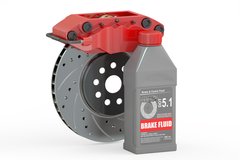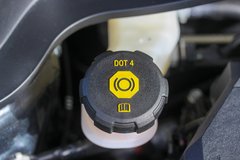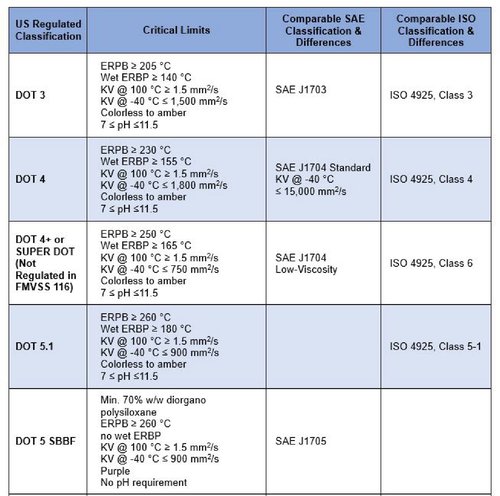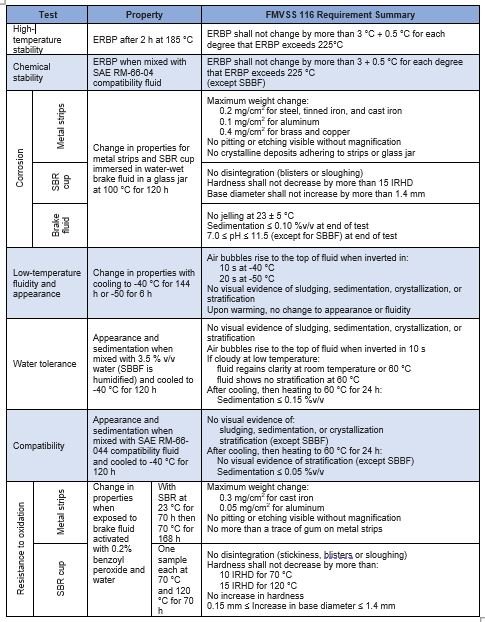Testing Critical Properties of Brake Fluids
 Brake fluids are unique among hydraulic fluids because they
are considered safety-critical vehicle equipment by the
National Highway Traffic Safety Administration (NHTSA).
Their primary function is to transfer braking force from the
pedal to the wheels while protecting brake system
components. Savant Labs conducts comprehensive tests on
brake fluids to ensure they maintain appropriate viscosity
across various temperatures, remain compatible with different rubber materials used in brake
systems, and do not damage metal components. Key tests include kinematic viscosity
measurement, compatibility checks, and assessments of fluid stability under chemical and
temperature stressors.
Brake fluids are unique among hydraulic fluids because they
are considered safety-critical vehicle equipment by the
National Highway Traffic Safety Administration (NHTSA).
Their primary function is to transfer braking force from the
pedal to the wheels while protecting brake system
components. Savant Labs conducts comprehensive tests on
brake fluids to ensure they maintain appropriate viscosity
across various temperatures, remain compatible with different rubber materials used in brake
systems, and do not damage metal components. Key tests include kinematic viscosity
measurement, compatibility checks, and assessments of fluid stability under chemical and
temperature stressors.
Incompressibility is another crucial property of brake fluids, as it ensures the effective transfer of force within the braking system. To prevent the formation of compressible gas pockets, brake fluids must have high boiling points and avoid air absorption. The Equilibrium Reflux Boiling Point (ERBP) tests measure the fluid's boiling point under both dry and wet conditions. Given these rigorous testing protocols, Savant Labs can build a testing package to meet your needs for a variety of applications.
Brake Fluid Classification
 Brake fluids fit into classifications depending on their chemical composition, viscosity, and boiling
point. The Department of Transportation specifies DOT 3,
DOT 4, DOT 5, and DOT 5.1 in FMVSS 116. SAE
specifications J1703, J1704, J1705, and ISO Class 3, 4,
5.1, and 6 mostly align with the DOT classifications with a
few minor differences. Even though the Department of
Transportation does not designate classes DOT 4+ or
SUPER DOT 4, manufacturers often apply these
designations to fluids meeting the additional requirements of ISO Class 6. Table 1 shows the
relationship between these classifications.
Brake fluids fit into classifications depending on their chemical composition, viscosity, and boiling
point. The Department of Transportation specifies DOT 3,
DOT 4, DOT 5, and DOT 5.1 in FMVSS 116. SAE
specifications J1703, J1704, J1705, and ISO Class 3, 4,
5.1, and 6 mostly align with the DOT classifications with a
few minor differences. Even though the Department of
Transportation does not designate classes DOT 4+ or
SUPER DOT 4, manufacturers often apply these
designations to fluids meeting the additional requirements of ISO Class 6. Table 1 shows the
relationship between these classifications.
Table 1. Comparison of classification specifications [1, 2, 3, 4]

The compatibility tests are almost identical across all DOT classes. Of course, because silicone fluid does not mix with water, tests for DOT 5 SBBF sometimes have different requirements. When testing to DOT 3, 4, or 5.1 specifications, the technician must mix water into the fluid. For DOT 5 SBBF, the technician must instead humidify the fluid. In some cases, such as for chemical stability and pH, there is no requirement for silicon-based fluids. Table 2 shows the tests and requirements for component compatibility in FMVSS 116.
Table 2. Component compatibility test requirements [1]
There are a few subtle differences between DOT and SAE limits for the stability and compatibility tests, so a fluid meeting the specifications for one classification may not necessarily meet the specifications for the comparable classification. Therefore, the actual test result is critical for understanding if a fluid meets both specifications. While the tests are nearly identical, SAE specifications call out test methods according to ASTM or DIN designations, and the FMVSS describes the test procedures and refers to SAE or ASTM standards only for materials, equipment, or calibration procedures.
The most significant difference between the SAE and FMVSS specifications is in testing for damage to mechanical equipment from repeated motion. The FMVSS uses a simulated brake system with referee standard braking cylinders. In contrast, the SAE specifications use an SRV tribometer, which measures friction and wear under oscillating motion.
Brake Fluid Specification Compliance
 In the US, manufacturers and packagers must self-certify that their brake fluids meet FMVSS-116
specifications. Manufacturers must conduct adequate testing to ensure compliance with DOT
classification and provide certification to packagers, who
must, in turn, ensure the fluid remains uncontaminated
and complies with labeling requirements [5]. Both ISO and
SAE classifications follow a similar self-certification
process [6]. The National Highway Traffic Safety
Administration (NHTSA) enforces these standards by
randomly testing products. If a sample fails the FMVSS116 test procedure, manufacturers may be requested to recall the product, and legal action can
ensue if they do not comply. Consumers can also report non-compliant products to the NHTSA for
investigation [5].
In the US, manufacturers and packagers must self-certify that their brake fluids meet FMVSS-116
specifications. Manufacturers must conduct adequate testing to ensure compliance with DOT
classification and provide certification to packagers, who
must, in turn, ensure the fluid remains uncontaminated
and complies with labeling requirements [5]. Both ISO and
SAE classifications follow a similar self-certification
process [6]. The National Highway Traffic Safety
Administration (NHTSA) enforces these standards by
randomly testing products. If a sample fails the FMVSS116 test procedure, manufacturers may be requested to recall the product, and legal action can
ensue if they do not comply. Consumers can also report non-compliant products to the NHTSA for
investigation [5].
Savant Labs offers brake fluid testing to the specifications of SAE J1703, SAE J1704, and FMVSS116, providing manufacturers with confidence in their product certifications and offering spot checks for packagers. Testing is crucial as some fluids may fail to meet the required standards due to manufacturing variability or contamination. Savant Labs ensures all processes are correctly followed and equipment is functioning properly during testing. Companies must closely monitor their brake fluids to maintain compliance and avoid costly recalls. A complete list of brake fluid testing provided by Savant Labs is available.
Contact Savant Labs to request a quote.
[1] FMVSS 49 CFR 571.116 (10/1/2023) https://www.govinfo.gov/app/details/CFR-2023-title49-vol6/CFR-2023-title49-vol6-
sec5 71-16. Accessed, May 5, 2024.
[2] SAE J1703TM MAR2024 Motor Vehicle Brake Fluid.
[3] SAE J1704 TM MAR2024 Motor Vehicle Brake Fluid Based Upon Glycols, Glycol Ethers, and the Corresponding Borates.
[4] Remmen Brakes. (2019, January 22). Brake Fluid: What you Need to Know [Part 2] – Standards. Accessed May 5, 2024.
https://www.remmenbrakes.com/brake-fluid-standards/
[5] Office of Vehicle Safety Compliance, NHTSA, OVSC Mission, March 18,
2013. https://www.nhtsa.gov/sites/nhtsa.gov/files/ovsc_mission.pdf. Accessed May 5, 2024.
[6] J. Light, SAE International, personal communication December 18, 2023
